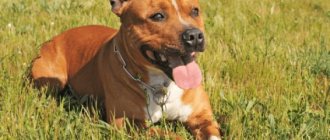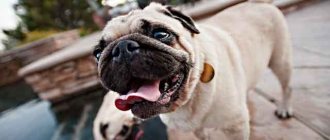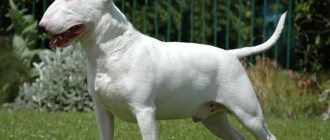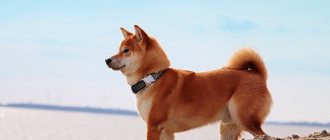“Bull terriers have made my life much richer and brighter. Thanks to them, I learned a lot about her and learned mutual understanding.”
— John G. Roemer
Champ.
Abraxas Apex ROM imported by Ralph Bowles. Justin was the consummate showman at the 1979 trade show, and his victory came as no surprise. Photo by Thomas Fall. The past of the bull terrier, like most other breeds, can be called “sports” - hunting and fighting - which corresponded to the needs and fashion of bygone years, when execution turned into an idle act and cruelty to animals and people was considered as something quite ordinary and natural . Of the different breeds of dogs, the bull terrier absorbed their best traits, but breeders and owners used their instincts for their own base purposes. The Boule of those years was distinguished by legendary courage, incredible endurance, insensitivity to pain and almost unsurpassed intelligence. These valiant qualities, which we admire in both men and animals, together with other virtues much less often remembered, made him a magnificent fighter.
The Bull Terrier has two more features that distinguish it from other breeds and allow it to become an excellent fighter, and today an ideal dog for a family. Firstly, this is the ability to make decisions independently and find a way out of a particular difficult situation. A dog that is unable to figure out how to repel the next attack in the fighting ring will inevitably die. Secondly, the bull terrier, despite the pain and passion for battle, does not lose his mind and does not bite his owner when he pulls him away from the enemy. Let's add to this a passionate thirst for communication with people and a friendly attitude towards all people, especially towards members of their family. Thanks to these qualities, you can not only trust children with complete confidence in the Bull Terrier, but also rely entirely on them at any difficult moment as a reliable protector and companion.
The modern bull terrier has retained all the magnificent physical and mental abilities of its formidable ancestors, but has largely lost its former instinct as a fighter. Despite the fact that in most cases it is other dogs who start the fight, the Bull Terrier never shies away from a fight. I have kept bulls for almost sixty years, and not one of my bull terriers has caused even the slightest injury to any dog or cat.
Story
Any bull terrier breed is shrouded in legends and myths, the bull terrier breed is no exception. In the 19th century Englishman James Hinks decided to breed a new breed , so the world, after years of trials and certain experiments, received a bull terrier. Previously, these were fighting dogs. They were set against bears and bulls. But in 1835 the cruel practice was banned.
Hinks decided to breed a dog with an aristocratic appearance and white color. The crosses used were a bulldog (old type), a white English terrier, and Dalmatians. There is a version that he infused the blood of Foxhounds, Greyhounds and Spanish Pointers. The breed turned out to be more elegant, streamlined in shape and its creator called it bull terriers. Lovers of strong, angular dogs chuckled.
The first dogs that were born under the leadership of Hinks did not have such a large, downturned, full muzzle. The Kennel Club recognized the Bull Terrier breed in 1933. Grandson Carlton Hinks continued his grandfather's work after World War I. With it, the dog’s muzzle has already become bent downwards - “downface”, just like in modern dogs. He died in 1975. Ten years later the breed already looked elegant and close to perfection.
The selection continued and the following were added to white:
- black;
- ginger;
- tricolor;
- brindle;
- red.
Thanks to the variety of colors, the breed has even more fans.
Staffordshire Bull Terrier price
When purchasing a dog of this breed, you need to know that they usually cost from 60,000 to 80,000 rubles. They are strong, cheerful, smart, they are easy to train, but if this is your first dog, then it is better to contact a dog handler to help with education, training and socialization.
After this, the dog will be the best companion in any of the owner’s endeavors. She will never leave you in difficult times and will always charge you with her cheerfulness and positivity.
Breed standard
Despite its relatively small size, the Bull Terrier is well developed physically, as evidenced by its dense body. The appearance of dogs of this breed is awkward; in fact, this is what makes the Bull Terrier stand out in the first place. The color of the coat is varied, and can be either one-color or three-color. Only blue and sand colors, as well as various pigmentations on white fur, are unacceptable.
- Dogs weigh 18-30 kg.
- Height 30-45 cm.
A miniature dog should not be taller than 35.5 cm, and can weigh 11-15 kg.
The main thing is that your dog does not look fat or very thin, but is strong and muscular.
- The head is low set, egg-like, long and looks strong. There should be no distortions or bends.
- Scissor bite.
- The lower jaw is strong.
- The nostrils are open and prominent.
- The eyes are brown and dark. They have a triangular cut and are narrow.
- The ears are located next to each other and erect.
- The legs are strong, muscular, and the dog is stable on them.
- The torso is rounded.
- Muscular, wide chest.
- The short tail tapers at the end.
Whites have black spots only on the head or ears. The colored one has more suits than the white one.
The difference between females and males
Nutrition
The Bull Terrier's diet may consist of special food or natural products. The animal only needs two meals a day; it is not allowed to feed the animal between these meals. If your pet eats natural foods, you should add a vitamin complex.
Half of the daily diet should consist of meat (cooked, raw). The second half is porridge, boiled or stewed vegetables and fresh fruits. Once every three days, the diet should include raw fish and eggs. You need to add vegetable oil (a tablespoon) to one of the daily servings. Regular consumption of fermented milk products is recommended.
The following foods are strictly prohibited:
- Fried foods.
- Smoked meats and sausages;
- I'll bake it.
- Sugar, spices.
- Pickles and canned food.
If you adhere to a diet of dry food, choose only high-quality and proven brands.
Upbringing
A “steady hand” is important for this dog. So that the owner is a reliable friend and the main one, to whom it is necessary to obey. It is important that the dog from childhood be in the company of people and dogs, actively and kindly communicate with everyone. Then he will grow up adequate, tolerant of strangers, balanced and friendly.
Scientists say that only 20% of a dog is a hereditary predisposition, and 80% is human upbringing.
Experts recommend this breed to experienced owners. A beginner with a soft character will have a hard time with a dog.
Contrary to many prejudices, the Bull Terrier is not an aggressive dog at all. However, you need to be able to keep your dog's excessive activity under control. Raising a puppy from a very early age will help in the future to raise an easy-going and restrained dog, saving the owner from the animal’s excessive stubbornness.
The tone with which the owner addresses his pet plays a big role in communication between a dog and a person. The voice should be made as rough and low as possible while the person is scolding the dog. In case of praise - softer and more subtle. During communication, you should definitely look into the dog’s eyes, so the animal will understand that they are addressing him.
By the time he grows up, the bull terrier should know such commands as “FU!”, “sit”, “place”, “toe!” and “give!” You should repeat these commands at home as often as possible in the appropriate tone so that the dog can recognize them by ear. All success in following commands should be accompanied by affection and treats. It is strictly forbidden to use physical force on an animal. This will only have a bad effect on both the behavior and the very character of the bull terrier, making it aggressive towards others.
Not everyone is able to tame the fiery temper of a bull terrier, however, despite all the difficulties of upbringing and training, he is capable of becoming not only a devoted friend and companion, but also a real defender of his owner! You just have to pay due attention to all the nuances of this breed and take a responsible approach to its maintenance and upbringing.
Character traits
Experienced dog breeders describe Bull Terriers as cheerful and loyal dogs, despite their negative reputation in society. These pets do not tolerate loneliness well, they are always happy to play with children of any age, and treat them very kindly and carefully. The character of a Bull Terrier can be described by the presence of the following qualities:
- Endurance.
- Bravery.
- Determination.
- Obedience.
The intelligence and intelligence of bull terriers can be the envy of many breeds. But they also have a significant amount of stubbornness, which can be eradicated with the help of proper education.
A dog of this breed is perfect as a best friend for active people. She will be happy to accompany you on your run. Such dogs need to devote a significant amount of time to physical activity and walks. This is how they spend energy, preventing it from transforming into aggression.
Choosing a puppy
It is best to take with you a person who owns a bull terrier, or even better, a breeder. If you don’t have such a friend, then study the literature on your own, watch dogs at shows.
What to look for?
- Ask the breeder and read the pedigree. It’s great if the breeder is a member of the Russian Canine Federation (FCI). With your dog you will be able to take part in exhibitions throughout Russia and abroad.
- If there were puppies from the same pair of parents, take an interest in their character and achievements (titles).
- Puppies are stronger if there are no more than 8 babies in the litter. Notice how the breeder cares for them?
It's good if the breeder:
- keeps a diary where he writes down notes about the development of children;
- removed parasites from the puppies and had 2 vaccinations;
- the enclosure is clean;
- The kids have clean water.
You can take a puppy up to 1.5 months. If the parents are healthy and strong, but experts recommend purchasing puppies no earlier than 2 months.
What should a bull terrier puppy look like?
Bull Terrier puppies with a large egg-shaped head, wide bones, and no discharge from the eyes or nose. If he is thin with a big belly, then the baby has worms.
Look at the bite. It should be scissor-shaped. Check your white puppy's hearing. Clap your hands or rattle keys and see how your dog reacts. You can hide it in the next room and carry out the verification procedure. If he doesn't respond, he's deaf.
Health
If you decide to buy a bull terrier puppy, then check it for deafness. It is quite difficult to understand whether a puppy, especially a small one, can hear you. But deafness occurs in 20% of white bull terriers and 1.3% of colored ones.
Due to their short fur, they suffer from insect bites, so a mosquito bite can cause allergies, rashes and itching. Otherwise, these are fairly healthy dogs that do not suffer from specific genetic diseases.
The average lifespan of a Bull Terrier is 10 years, but many dogs live up to 15 years.
Care
Nature has rewarded the bull terrier with good health. Thanks to this structure of the skull, the eyes are deep-set and are less susceptible to mechanical bruises, and erect ears, unlike hanging ones, do not require excessive attention: it is enough to clean them with a cotton swab once a week.
Wool
The Bull Terrier breed is a smooth-haired dog, which is why the coat does not require special care. Shedding occurs twice a year - in autumn and spring. Dead hairs can be easily removed with a brush or a damp sponge.
Claws
More attention should be paid to the dog's claws. As a rule, they wear off during a walk, however, if the claws still begin to grow beyond the pads on the paws, they should be trimmed yourself.
Walk
Daily walks are of great importance in care. The Bull Terrier is an extremely active dog, which is why it needs long (1.5 hours a day) and intense walks. Active activity allows you to release the dog’s excessive energy into playing with the owner, and also eliminates unwanted obesity, to which this breed is predisposed.
Diet
The dog's diet should be varied and always fresh. Dishes should not contain fatty foods, sweets or white bread; you should not give exotic foods, as the bull terrier is prone to allergies.
A new type of food should be introduced into the daily diet gradually, in small portions.
This is especially true for puppies that new owners purchased from breeders.
Do not forget that a dog needs proper nutrition in order to be in good physical shape, and, importantly, in a favorable condition in general.
Where is the danger hiding?
Owners of a dog of this breed should not forget about the purpose for which bull terriers were bred - they are fighters at the genetic level. Only with poor upbringing does a dog become uncontrollable when it feels threatened by other animals. During walks, a fighting dog can easily get into a fight with another dog.
Experts do not recommend keeping a bull terrier in the same house with other animals. After all, his fighter instincts may suddenly awaken, but they usually get along well with cats. Your pet should feel your love, but don’t let him forget that you are the main one in the house. Representatives of fighting breeds must be brought up in strictness from childhood. This is the only way to control a dog.
When playing with a bull terrier, it is prohibited to take away his toy, lay claim to his things, or tease adult dogs in other ways. They are possessive and can react unexpectedly.
What to feed
Bull Terrier puppies grow quickly - by 9 months they reach their full height. The dog's further development consists of gaining muscle mass. During the first four months, dogs gain up to 30 kg of weight. Due to the unusual indicators, the owner is called upon to pay careful attention to the balanced nutrition of the animal, and not to feed leftovers from the owner’s table.
Remember, the breed is prone to gaining excess weight. As a result:
- A 1.5 year old dog needs one full daily meal, not more often.
- Teach your pet to seek food only in moments of true hunger.
- Avoid adding too much food so that there are leftovers in the bowl.
- Gourmet dishes will spoil the dog.
- Two thirds of a dog's diet is meat.
- The last third is obtained from foods high in calcium and minerals; fish oil is useful.
What to feed bull terrier puppies:
- Feeding puppies is done more than once. The meaning of nutrition does not change.
- The food is balanced and contains healthy foods and minerals.
- To avoid the process of obesity, it is recommended to walk the dog for a long time at least twice a day; the dog is shown an active lifestyle.
Rat exterminator and pet
Bull Terriers are excellent hunters , although completely different breeds were used for these purposes in England. However, in competitions for the destruction of rats, which were held in public, boules had no equal. A powerful, seemingly slow-moving dog, demonstrated miracles of mobility and maneuverability. All records for the destruction of rodents belonged to bull terriers.
In those years, sports competitions involving dogs were extremely popular - aristocrats and hunters invariably attended them. The new breed aroused keen interest with its numerous talents.
The endurance and natural strength of the dog were especially impressive - only the bull could support the weight of the body with the force of his clenched jaws. Having jumped up, the dog grabbed a tree branch or a suspended tire with his teeth and hung for 2-3 minutes. Such sports activities gave the dog real pleasure.
Predisposition to disease
No specific genetic pathologies have been identified in representatives of the breed, but they are most often exposed to certain diseases. This:
- dislocation of kneecaps and elbows;
- turning of the eyelids;
- joint dysplasia;
- aortic stenosis;
- epilepsy;
- deafness.
An adult pet is at high risk of developing cancer. Puppies can suffer from a rare disease - lethal acrodermatitis. These animals have very thin skin, so in summer they need to be protected from sunburn and mosquito bites, which can cause hives and severe itching.
Video
* We invite you to watch a video about the Bull Terrier . In fact, in front of you is a playlist in which you can select and watch any of 20 videos about a given dog breed by simply clicking on the button in the upper right corner of the window. In addition, the material contains quite a lot of photos. By looking at them you can find out what a Bull Terrier looks like.
In this article:
|











